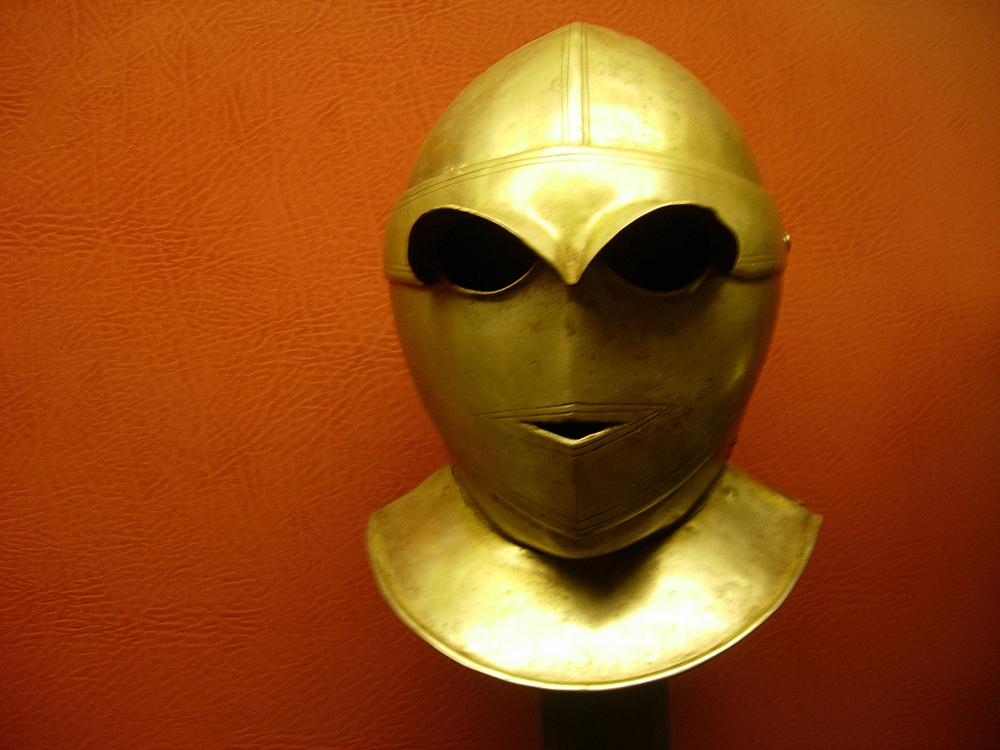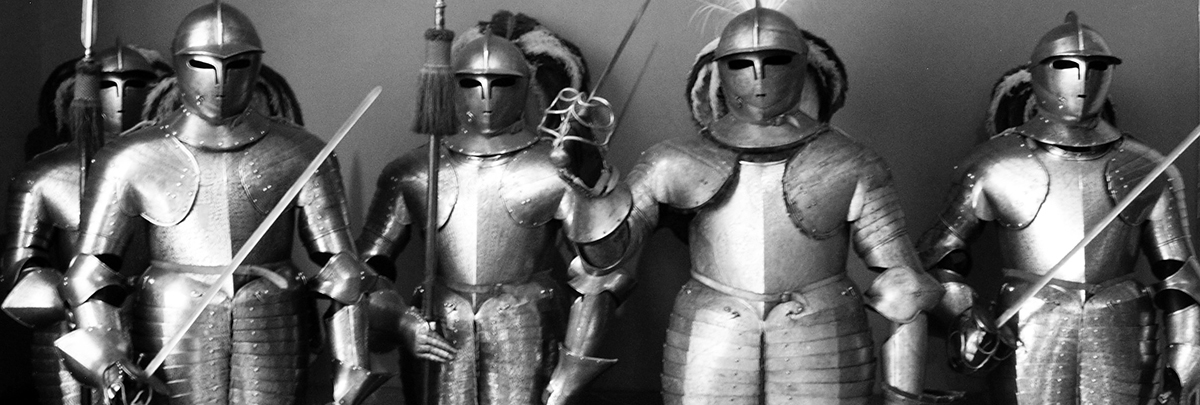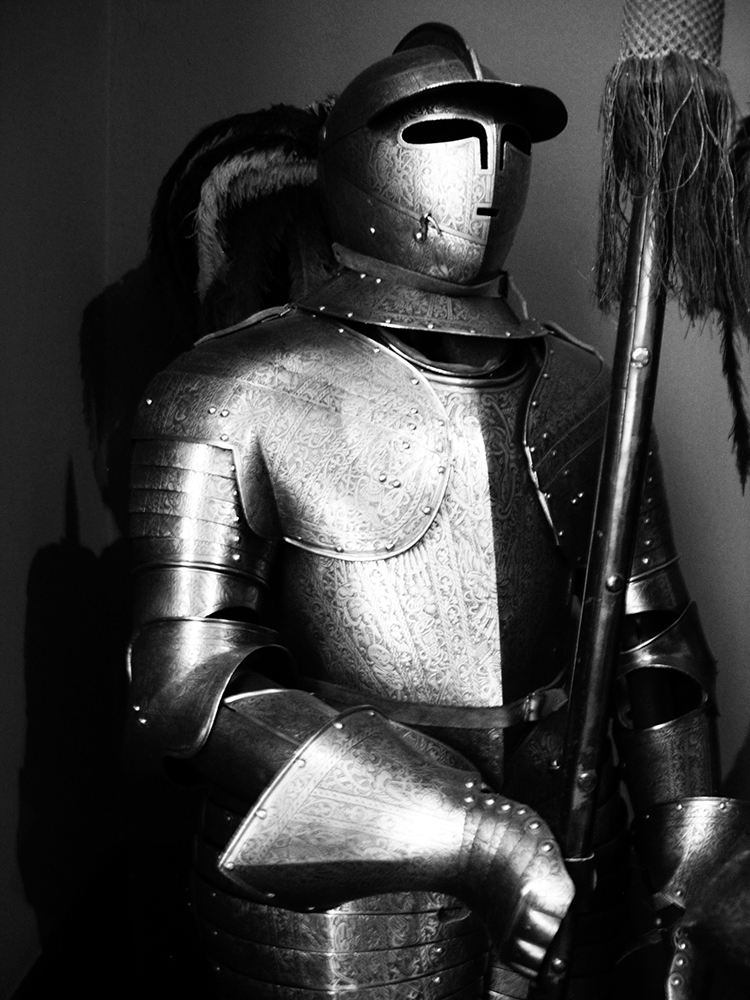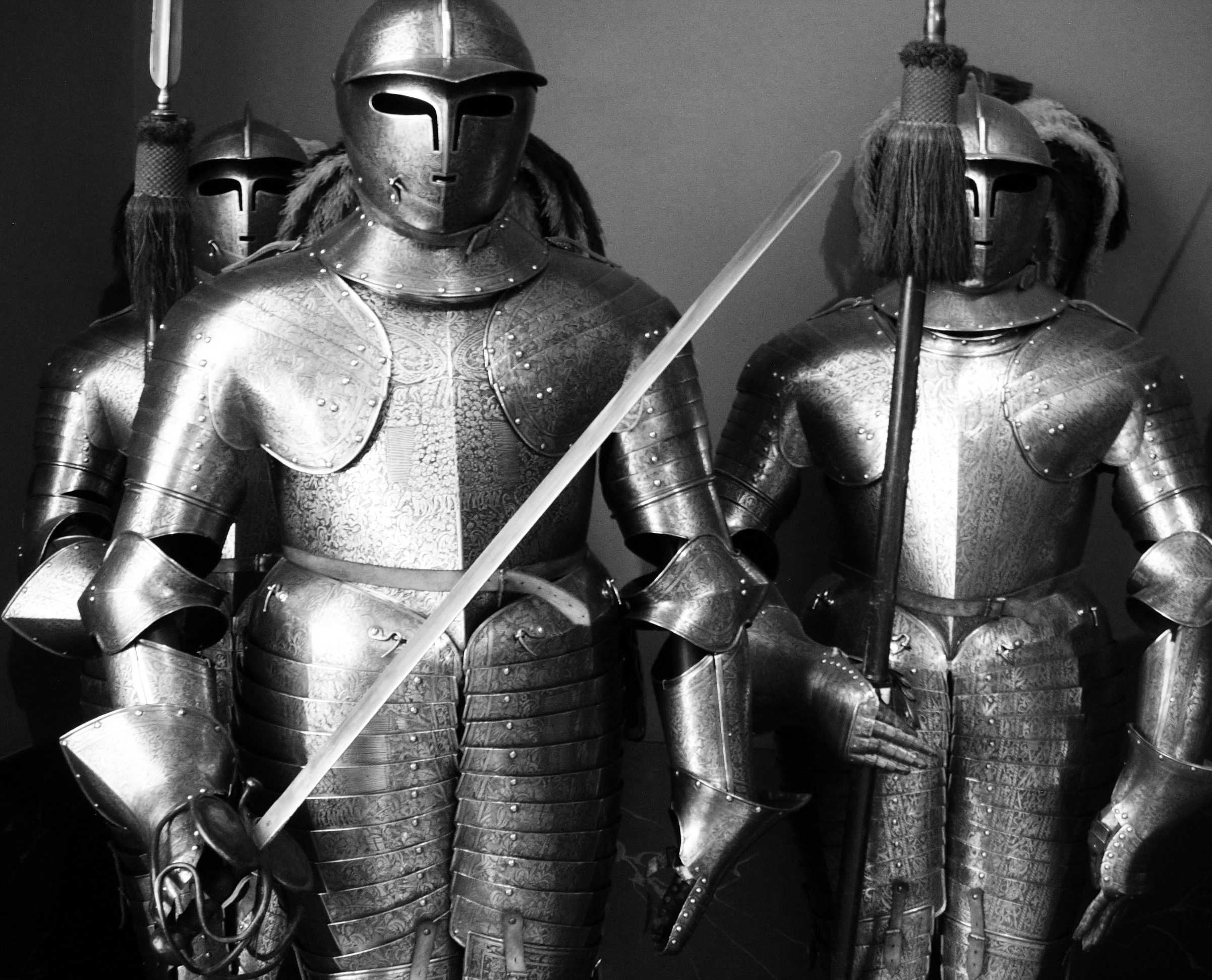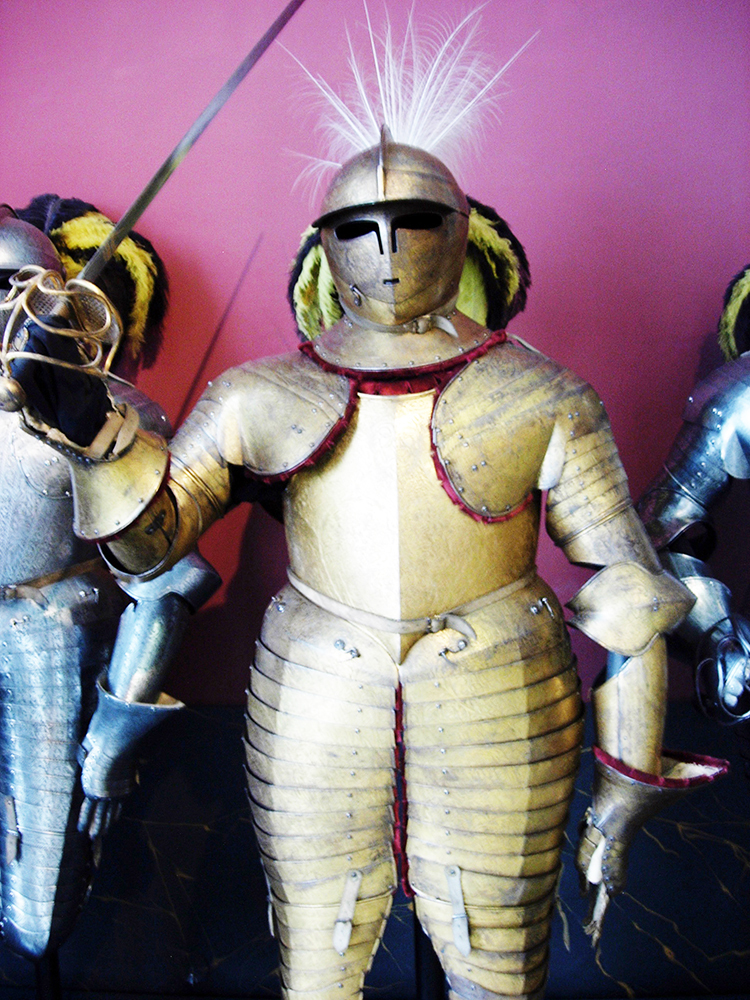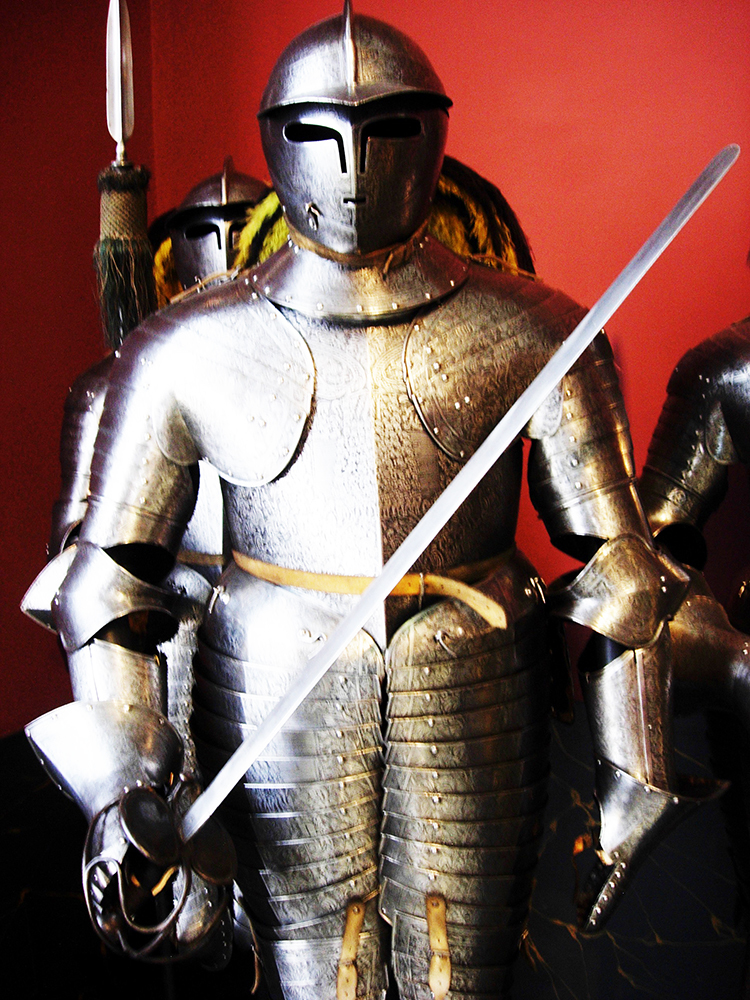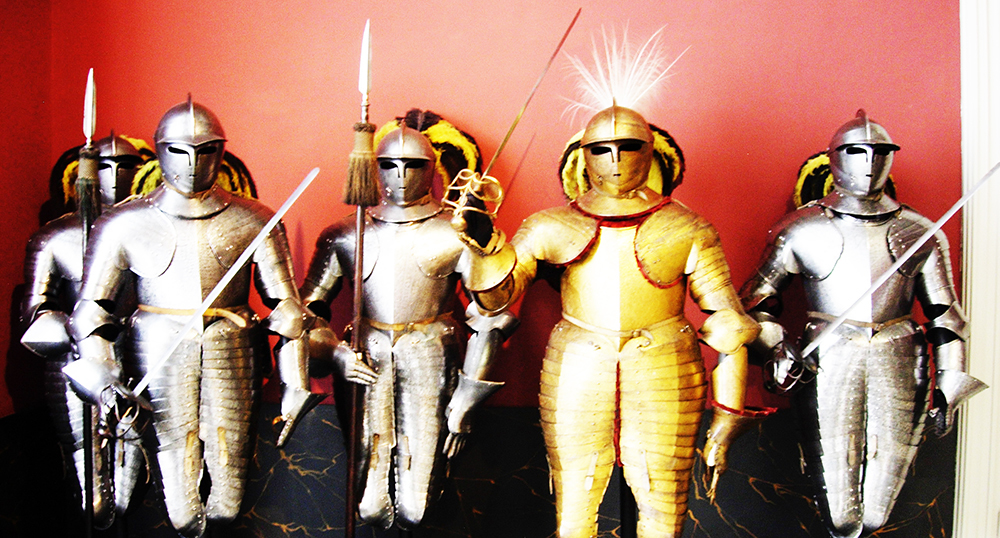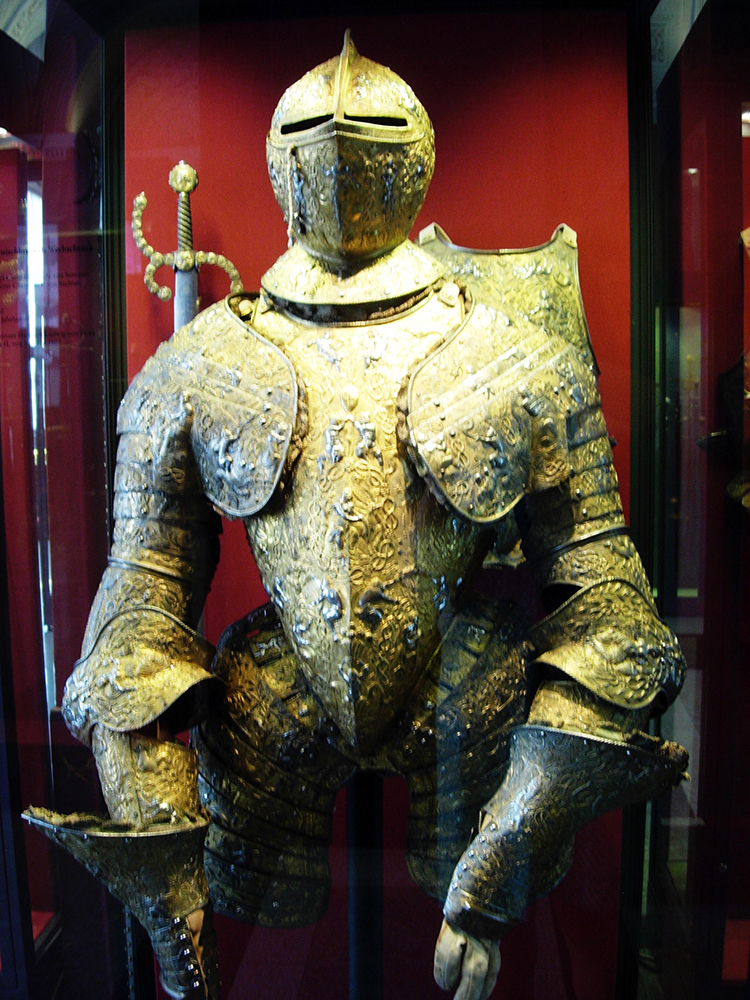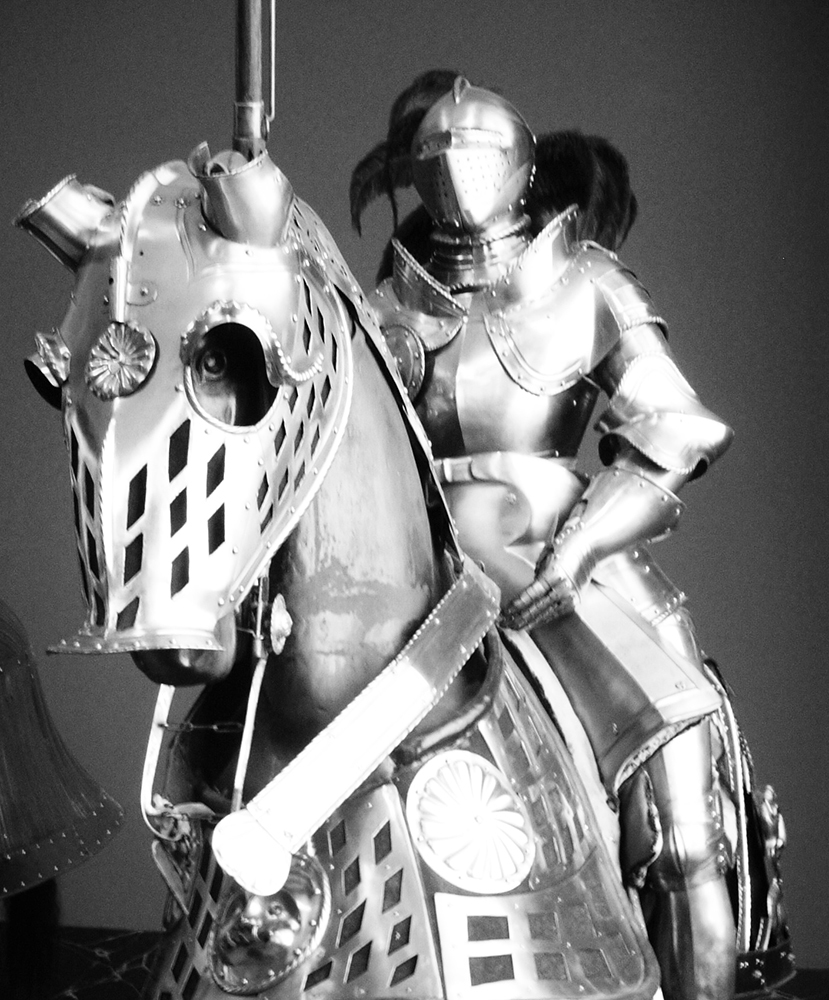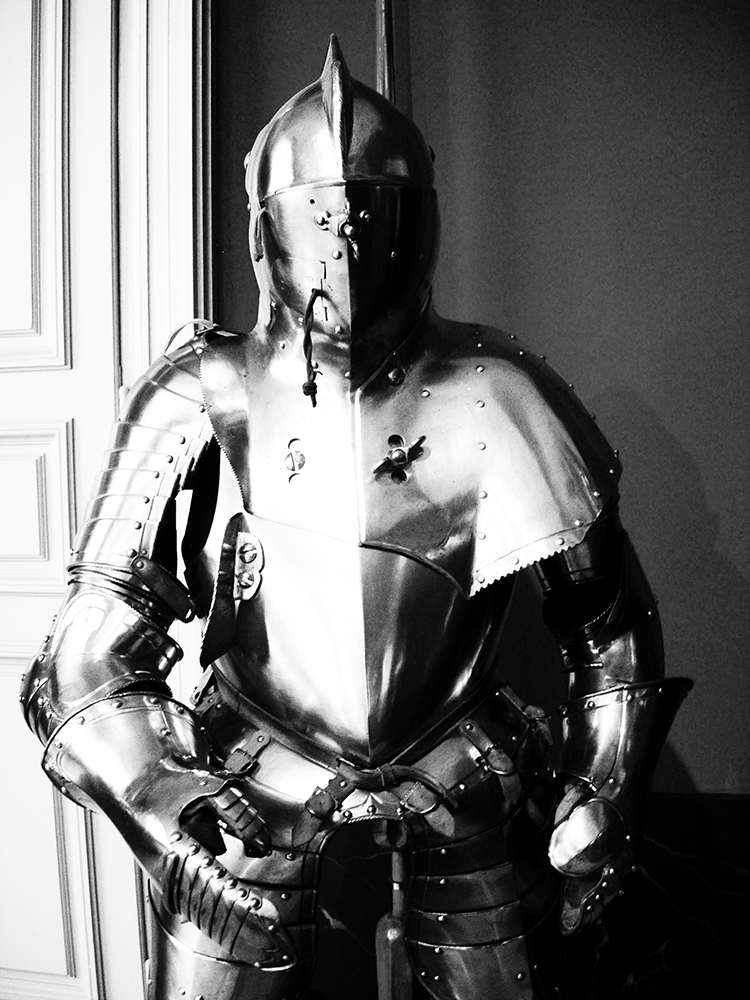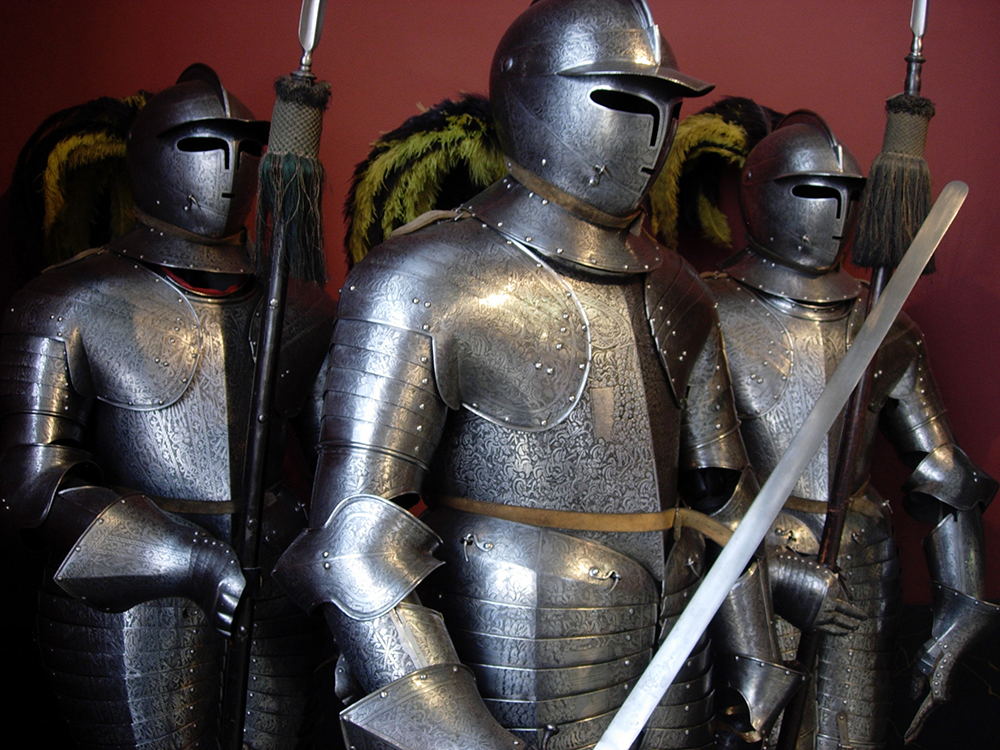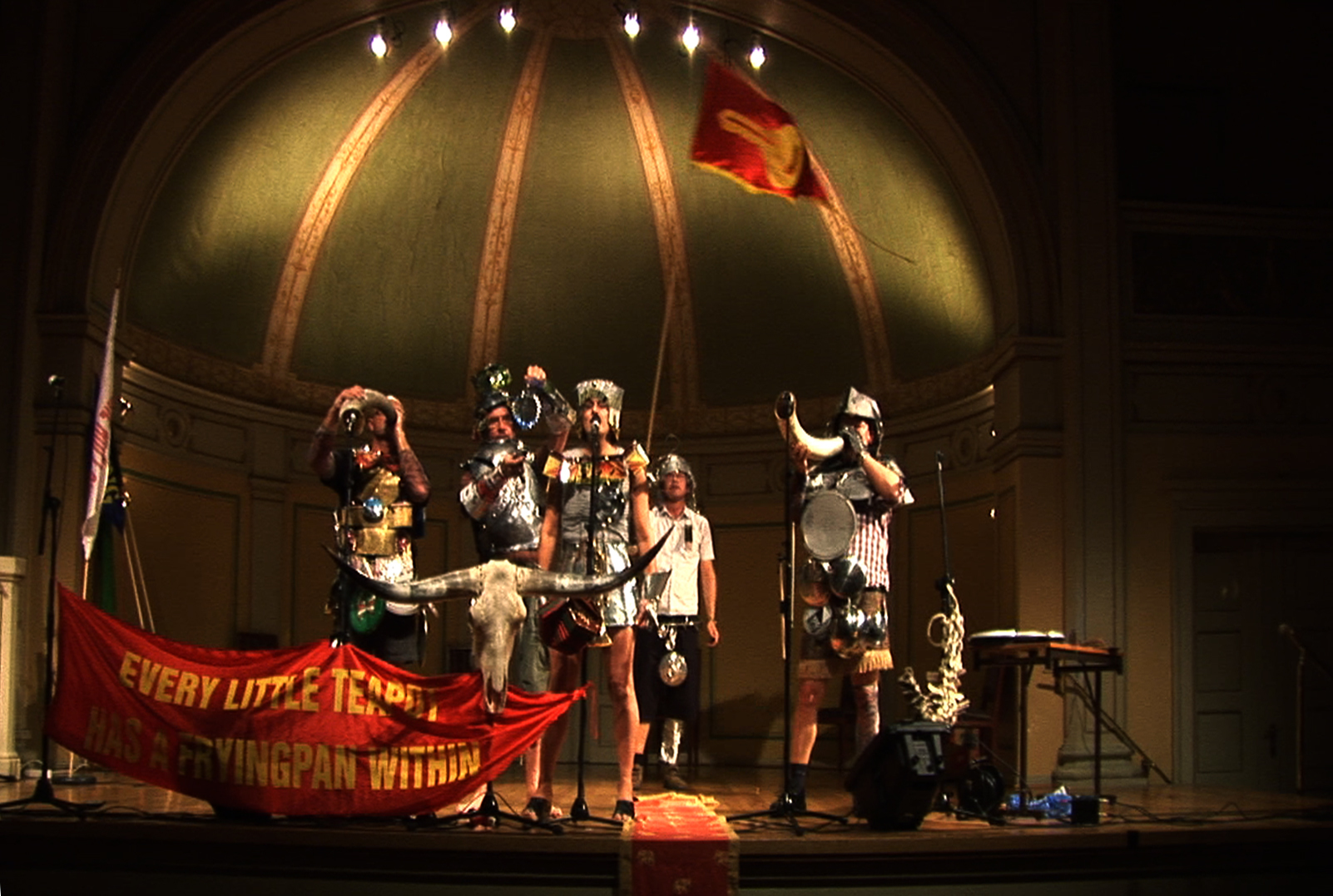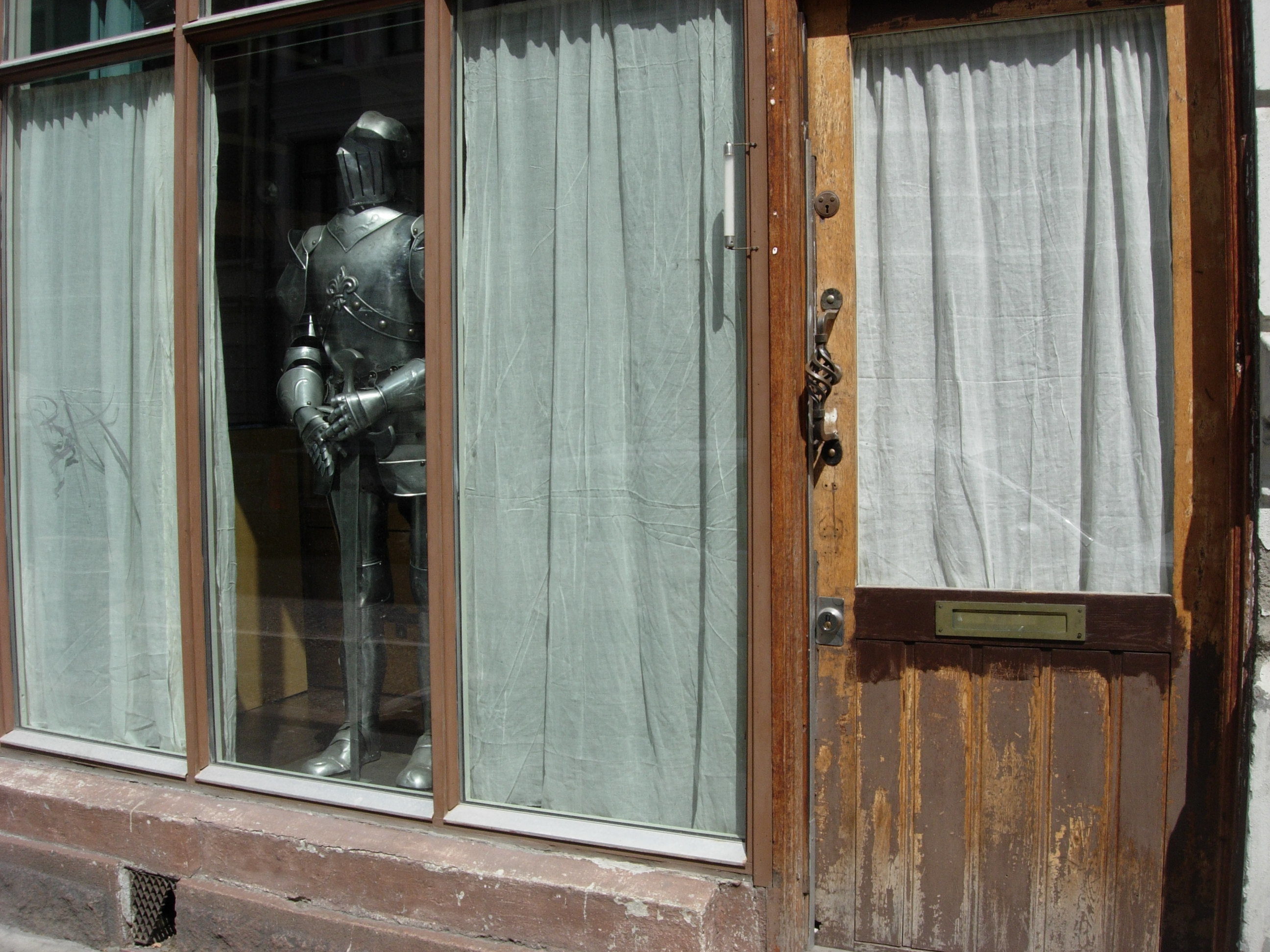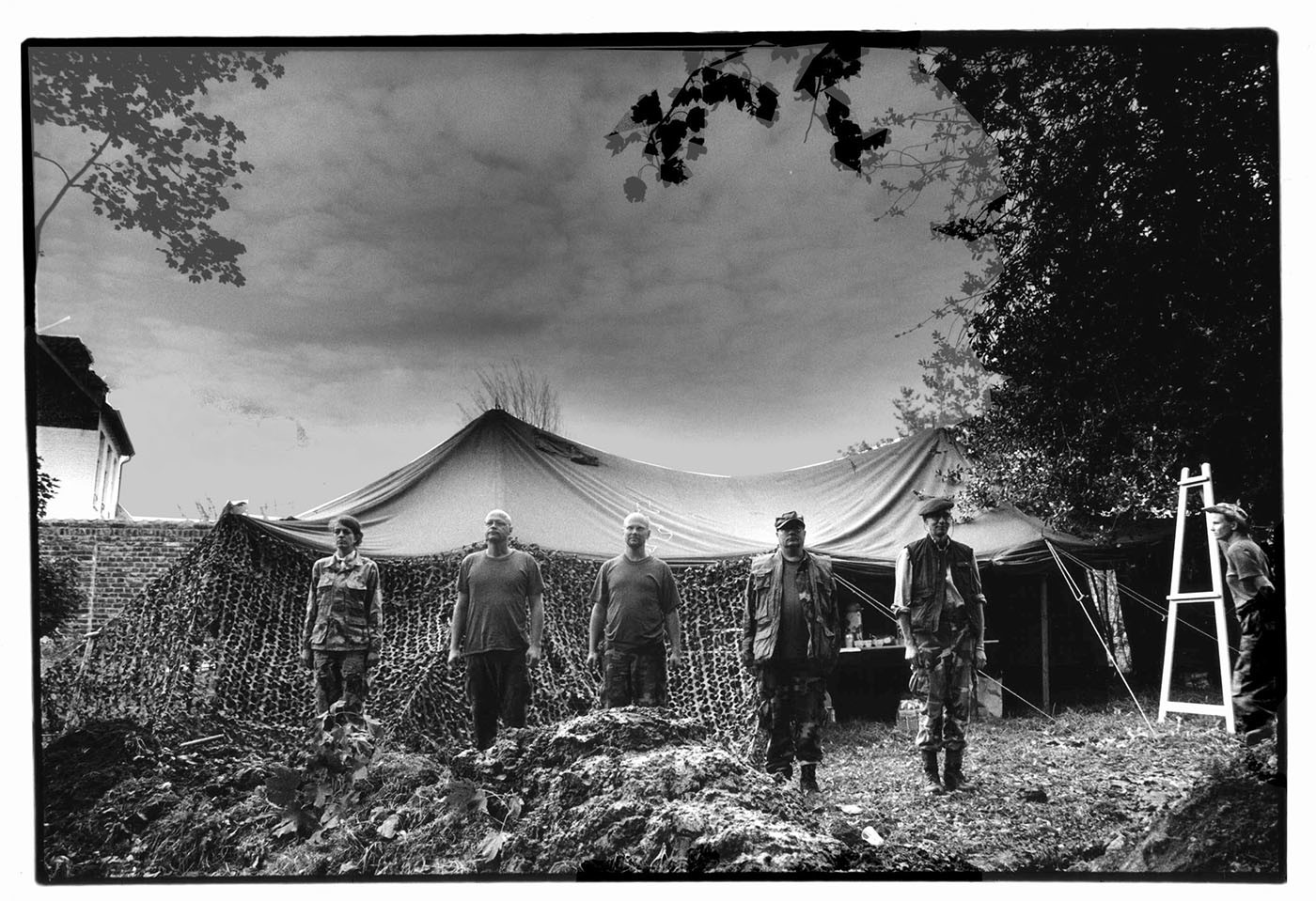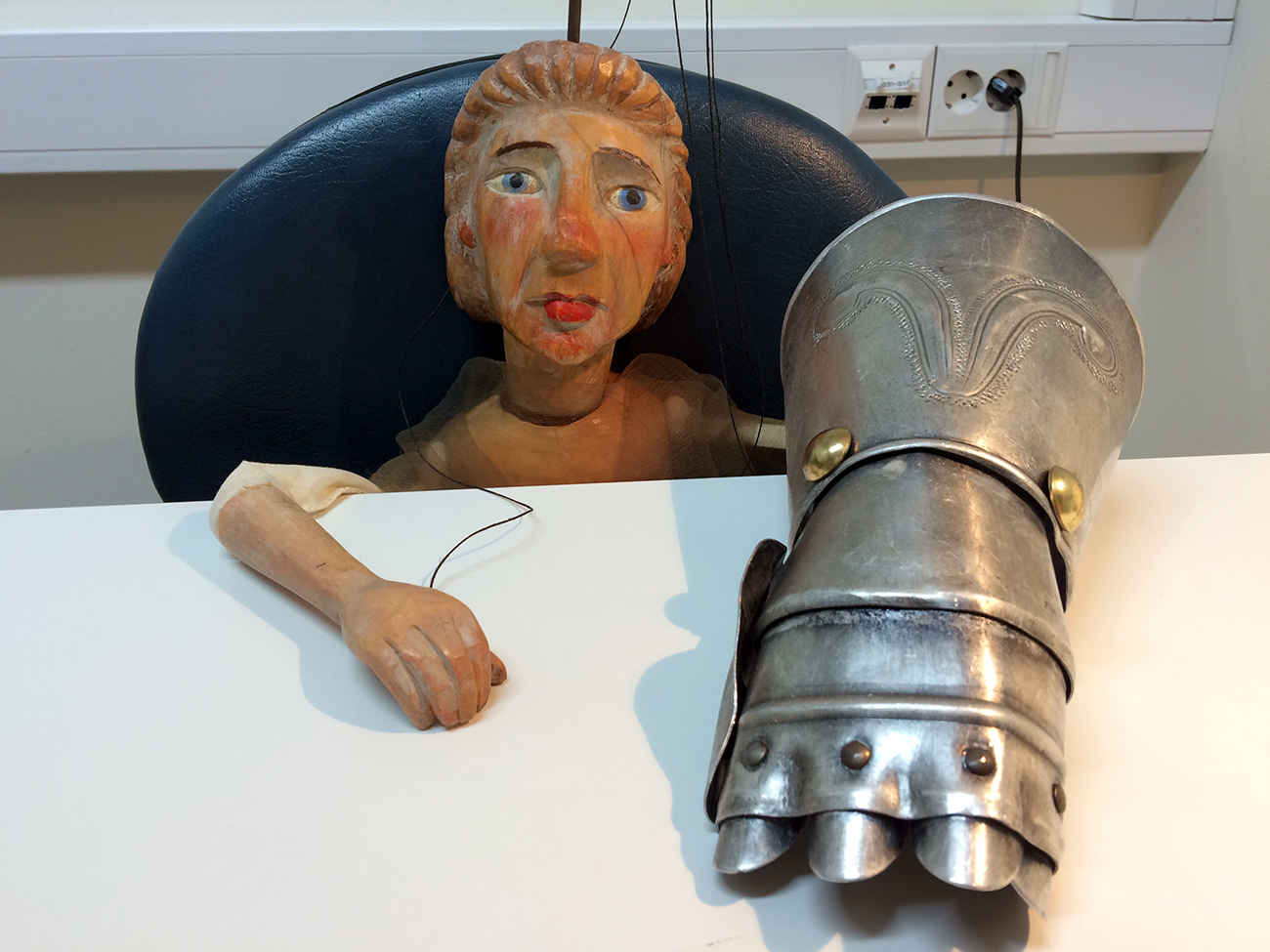We and I
Politically alarmed Armor lecture.
On the Artist Collective Baktruppen and Me.
(Read it on a computer to see the belonging photos – PPP)
Performance lecture at the Department of Arts and Cultural Studies, University of Copenhagen 1/4/2019. Commissioned by Curriculum – public school of performance art, curated by Cecilie Ullerup Schmidt.
The text is based on my script and the specific situation with me and the audience on a sunny spring afternoon in Copenhagen. It took place in a big, modern auditorium with about 100 seats, a powerful projector, a big screen, an ok sound system and big windows. The audience was small but looked nice. I wore my costume from BAKTRÜPPEN LIGHT METAL BAND, a show about the financial crisis of 2008. The lecture had been announced as an ideological fight for the ambiguous and messy collective. Based on history and an overwhelming number of topics, with several examples of works, books and performances, it commented on an ongoing and growing crisis. Mainly it was a short, but not a true story of Baktruppen: a group of individuals who were together not because we agreed but because the collective structure provided methods whereby we could explore in ways that surprised even ourselves.
Thanks to Cecilie and PERIPETI who wanted to publish the lecture more or less as it was, even if they actually wanted more about the inner life of Baktruppen – the stories, the differences and why we split. It’s not really about that, even though I did say a bit more in the lecture. In the end it’s about me, of course, and my PhD SPACE AUTOMATISM: on what space and context do, with place itself as the protagonist in a series of object-oriented portraits. The text is a description or a site-writing of that specific performance lecture as it was, neither better nor smarter, and certainly not very analytical or theoretical, but mostly vulgarly bombed with cut-outs and photos. Thank you to Veit who agreed to write the contextualizing intro. I believe an outside eye is best for that.
WE AND I – Copenhagen Lecture.
Hello. I’m in Armour.
I show myself and walk back and forth. I shake hands with everyone with my armoured glove. We talk a bit. I use the automatically driven curtain system to block the sunlight. It gets darker.
PP 1 – 50) Fifty photos of armour. It is all quite lovely and stupid looking, as I am myself. There are feathers and groups and children and even horses in armour.
This lovely costume is from Baktrüppen Light Metal Band, made during the financial crisis in 2008. I’ve travelled the world in this.
PP 51–73) I show 22 photos of Baktrüppen Light Metal Band travelling the world – from the top of a mountain in Lofoten, Norway, to the streets of Hanoi, Vietnam. I talk a bit about it.
I’m here, but Baktruppen is dead. Not the people, but the collective, and, as far as I know, that specific collective method is mostly dead as well; the flat structure in administration and artistic disciplines, where WE did everything and WE got credit for everything, which meant no division between artistic disciplines or categories: no director, no scenographer, no composer, no actor, no writer, no sales department, no economy. That we weren’t naturally good at any of that or educated in it was something we looked upon as an advantage. A clear concept in a risky situation was the important thing, and a ‘well-performed’ performance wasn’t even artistically interesting. We were good at being bad, at continually changing and at making variations or situations where we could possibly fail. Most of the time it was hard work to find and agree on a concept, so we talked much more than we rehearsed. We claimed rehearsing was for cowards and made it meaningful to be badly prepared in front of the audience.
I’m afraid this lecture will be a bit bad as well. The topics are big, and there’s too much history. I’ve tried hard to organize it, and to say something new but, in the end, I decided on the armour.
I’ll give examples of works, and I’ll do vulgar image bombing. I don’t even write a lot about it but use excerpts from texts that are already on our website. They are good texts, and I guess you wouldn’t find them yourself anyway.
As you can see it’s related to Baktrüppen Light Metal Band where we sang songs about capitalism and teapots. Today it’s without teapots. But there is a flowerpot.
I show and tell them that my helmet is a pickled cucumber bucket, that parts of the front and the back are cake boxes, that the rest of the front is part of a stove, that there are Norwegian kroner hanging from it, and that my skirt is made of an Ikea flowerpot.
PP 73–74) These group photos from 1991 are taken with a camera obscura at the top of Fløybanen in Bergen on a windy and cold winter day, and those of us who didn’t move much have come out the sharpest.
I point and say the names of each one of us and where we all are now, but some of us are so blurred I’m not sure who is who.
PP 75) This is us at the opening of Lillehammer Painting Collection in connection with the Olympic Games in Lillehammer in 1994. The performance was called SPEECH FOR THE ART, THE QUEEN AND THE VANITY. We climbed this big metal sculpture (I point) sticking out from the wall, by the artist Bård Breivik, and played it like a didgeridoo. And that’s the Queen. And that’s me.
PP 76) This is us at Trondenes Fort in Harstad, a military camp with an enormous cannon called Barbara, from the Second World War. I don’t remember why I chose this photo for the PowerPoint presentation, because the same year we did the famous TONIGHT :-) – a hypertextual lecture on industry, technology, time and memory on 350 m2 synthetic carpets in the industrial halls of Kampnagel in Hamburg, and I have to remind you that 1994 was early in the life of the internet.
PP 77) Here we are POLISHING THE TROPHIES OF SONIA HENIE, the famous Norwegian ice-skating queen. She and her husband established an art museum right outside Oslo called Henie Onie Kunstsenter where we spent a couple of weeks polishing the trophies. The photo was taken when the job was done. All the trophies are shining and we don’t have our shirts on.
PP 78) This is us from a trip to Hong Kong. The photo is taken on Lantau Island, where the airport is now. We are dressed in Chinese costumes and try to fly our Chinese dragons on a beautiful white beach; the sea and the sky are greenish and blue behind us. The photo was taken during the production of the performance GOOD GOOD VERY GOOD where we made hard liquor on stage and said “cheers” to alcohol, the Sami People and the Chinese, and proposed that the two peoples should join forces.
PP 79) The Sami People didn’t like the idea, and they didn’t think it was funny either, but they drank our stage-made liquor, and the photo is of us with scooter dresses on snow scooters on a clear sunny winter day outside Kautokeino in Finnmark.
PP 80) At one point we started to talk about having group sex, to try it for real, being a collective and all that, but as you can see from this photo, we ended up with foot sex. It’s taken in the bar of City Hotel in Oslo. In the upper right corner, you can see former ‘prince’ Ari Behn, who at the time was only a poet who was just coincidentally invited to come along by one of us. He enjoyed it, as you can see from his smile (since he is not sucking toes), and later the photo ended up in the celebrity press. (Ari Behn died this Christmas. R.i.P.)
PP 81) This photo is taken in front of Oslo courthouse. It’s called BAKTRUPPEN AS WALL, where, in the absence of legal wall space for graffiti, we acted as a wall, wearing white painting overalls, for the writer Goal.
PP 82) This is a group photo and a teaser for the show EUROHÆ? in leather and blood and black metal. We gave a record player to the author Dag Solstad who went on an interrail trip from Moscow to Dublin, and then we made a floppy Euro horror show based on his reports.
PP 83) And this is us as Neanderthals, at the exact spot where they found the first bones in Neanderthal in Germany. That’s obviously why we don’t have any clothes on. It was part of the show HOMO EGG EGG about the different identities of mankind, seen through Neanderthal eyes. Which was performed in separate rooms, with the audience looking at it all on live video, and they could only get into our spaces by playing table tennis with one of us.
PP 84) As you can see from the photo, we later performed it on Viagra, from under the Amphi as bodybuilders with sun cream.
PP 85) This is us in Kampala, Uganda, together with the staff at Kampala National Theatre. We danced the performance DO & UNDO where we do and undo knots and unknots, during three entrances, two exits and one turning point, in skin coloured and black bodysuits as we stupidly came to call it in black-skinned Africa.
PP 86) This photo is from Homo Egg Egg as broadcast live on radio, performed naked in animal body paint, at ZKM in Karlsruhe, in the performance BALD KOMMT DIE GANZE GESICHTE VON IDENTITÄT UND IDENTITOT! I wasn’t there, since I was playing old songs on a harp and reporting live from a pig farm, all alone except for the pigs, out in the pitch-black countryside.
PP 87) This is a photo of us skiing and falling at an annual meeting in the mountains of Norway.
PP 88) This photo is us outside Montemor-o-Novo in Portugal jumping up towards the sky in brightly coloured bodysuits. It’s from the dance performance DELI COMMEDIA, a cover of Merce Cunningham's slapstick choreography from 1985. We were useless as dancers, of course. None of us had any training whatsoever, but we tried as well as we could to copy every movement in the dance from looking at a video of it.
PP 89) It was performed in New York, and we very briefly met Cunningham in his studio where this picture was taken. We were star struck, and two of the original dancers saw the performance and thought it was hilarious.
PP 90) This photo is from outside Oslo Stock Exchange. We are insolvent ghosts in white bed linen for the production of DARIO FO'S CORPSE FOR SALE, which was shadow theatre, and where we publicly cancelled our jubilee show about Norway.
PP 91) This is from a project for local TV called THE EUROPEAN COMMISSION where we are undressed and half-naked like dogs in chains and locked out in the cold snow.
PP 92) And here we are: the armour show. This photo is from Malta, where you find one of the biggest money factories in the world. We tried to get in. They wouldn’t let us in. I’ll show you how it went a bit later.
PP 93) The end. This is a photo of us delivering all material for archiving and digitalizing to the National Library in Oslo, as the first group ever to deliver interdisciplinary material.
PP 94) A photo of a group in armour.
I was asked to talk about Baktruppen. But Cecilie also asked me to say something about the recent debate in Norway and the performance Ways of Seeing. Part of their scenography was a video of the fronts of houses belonging to the people they claimed were making Norway a more racist society, and the performance was, among other things, an example of how our borders are constantly moved towards more surveillance, and how the direction of this surveillance is rarely directed towards the real criminals in society, and that the surveillance of people with ‘undesirable’ political or religious views is now done legally and on a full-scale level, something that was illegal in the nineties. Among the people whose houses were shown was the (no longer) minister of justice, Tor Mikkel Wara. His wife came to hear about it, saw the show, and even though claiming to be a very private person, wrote about it in one of the biggest newspapers in Norway. She got everyone’s attention and sympathy – no one likes the idea of being filmed secretly at home (although nobody was visible in any of the videos), and then have it shown in public, even if it was a performance that almost no one would see. It could have remained almost invisible like most of the productions from the so-called independent theatre groups, but that was before she, the wife, made it famous because not only did she write about it in the newspaper but she also followed it up in a spectacular way, making the right-wing victim story true somehow by faking attacks on herself and her family (she is charged but not convicted yet).
Media and the government reacted to it really badly. We’re nothing to those with power. It seemed they didn’t even think of the people in the performance as people but were referring to it or them as ‘the theatre’. But the (real) people in it got a shitload of abuse, especially the women, of course. They’ve been constantly vilified on the internet and have been completely and consciously misinterpreted in the media; even the prime minister said that they shouldn’t have done what they did because it endangered the politicians (!). The venue (Black Box Oslo) itself didn’t do much other than withdraw. Even colleagues turned against them, at least in the beginning, believing the right-wing victim story. And then colleague turned against colleague, arguing about who took the side of who and why, and who understood the consequences: like freedom of speech, for instance. The confrontations got quite heated. But at least they got the attention they of course wanted in the first place, and in the end they also got to speak about the content. And now the show is played everywhere, which is great, but I don’t know where it got us politically – to a more polarized place, it seems. I saw the performance on the third night or thereabouts, and the video of the house fronts is completely innocent. Like this:
PP 95) A photo taken from outside Baktruppens office where a full suit of armour is standing in the window facing the street.
Or, their house fronts were much more innocent. Nicer looking. And completely without the visible armour.
Cecilie also asked me to say something about why Baktruppen split. Maybe it was sort of a depression. Concerning precisely art and politics, and the Norwegian theatre discourse. It’s tiring to be ahead of your time, to be the underdog. It was always poorly paid, and it didn’t get better. Some wanted to do their own thing. It was and is all about what you achieve individually. And some simply wanted more work. Since we all needed to make money elsewhere, it was hard to find time to be together and the specific collective structure made it difficult to split into smaller groups for different projects. It was basically everyone or no one. And besides, ‘to end’ was a concept we had not yet tried. How can we end? I don’t know if we fully realized that it would be the real end. I wasn’t sure I wanted it to end and was somehow surprised when it happened for real and forever. I like the idea of togetherness in a collective, the method of WE, both artistically and politically. It was safe for the right reasons. It still feels important. Conventions are strong and are getting stronger. Being together is even more important.
But I must admit it was complete war sometimes.
And now it's just me, which is a change, of course, after 24 years as a collective, to be I, not We. Politically, I’m against it, I didn’t need to be that individual artist. But as you will see later I've developed some methods.
PP 96) A photo of Baktruppens Amphi in Dælenenggata, Oslo.
And my work after Baktruppen started here, with this space which for the last years was our office and theatre. It used to be a small shop with a big window facing the street, but as you can see it’s now a small theatre space with a beautiful handmade Amphi. I inherited it, nobody else wanted it, and I shared it with neighbours and colleagues for about a year, using it for installations, artwork, concerts, and a lot of meetings on art and politics. Then it was lost to the market.
The ways of Baktruppen seemed more and more difficult within the all-encompassing neoliberalism and the so-called professionalization and new public management in institutions, which must be great for administrations and curators, who grow extensively in numbers and wages, but not so good for artists who must explain and sell their work years before it’s actually made, and still lack spaces, money and security.
My first space protagonist (or portrait) was Baktruppens Amphi, and then it was this:
PP 97) A photo of Kunstnerskapet.
I call it KUNSTNERSKAPET: «fra fellesskapet til kunstnerskapet». A one-woman piece made from the left-over pieces of the collective. The collective turned into an individual. A group made into one single entity. A political idea about collectiveness and another one about identity. The collective Amphi was small and not very impressive but it worked. This one is as small as a closet, or a coffin (when laying down). I’m inside it, you can see my feet sticking out. It’s not a very practical or elegant theatre space or artwork, but it has doors and windows, and it can move.
I show them a book.
This is Laughter and Dialogue, by Mikhail Bakhtin. It’s completely relevant, but I won’t talk about it much. I was part of a Carnival in Oslo recently organized by the artists from Ways of Seeing, and I won’t talk about that either, but I got into it precisely because of Bakhtin and his carnivalistic ideas on turning things around, and the importance of vulgarity for the more serious stuff. Because comedy is ambiguous and admits it doesn’t understand everything, while tragedy is a know-it-all screaming monologue.
I show them another book.
I brought this one as well, which I’m reading right now, Timothy Morton’s, Being ecological, on the philosophy Object-Oriented Ontology, about why it’s good to think about everything including humans as equal things or objects, to look for the inner value of everything, and how things are always more than they seem to be, especially if we look at them/ us without looking at whether it’s useful to us. I promise I meant to talk more about it, but Baktruppen, too, looked really carefully for the hidden stuff in everything.
PP 98) We stand very cool looking down at a camera placed on the floor. On a white t-shirt it says KEEP NORWAY HIDDEN.
I guess most of you didn’t know much about Baktruppen before now. But without modesty I have to say that you should know about it. It’s had a huge impact in Norway and is central for how independent theatre developed through the nineties up until now, and for how theatre schools in Europe developed, and for new groups coming out, both nationally and internationally. It’s recent theatre history, but not very much talked about. In Norway they might even be happy we’re not there to bother them anymore, so they can pretend it never happened, but copy for all that it’s worth, which is cool too, and only natural, but I don’t know what it does to the discourse.
PP 99) The website.
This is our website. I was responsible for it for the last ten years, until 2011. It’s not that old, but a lot of the links don’t work anymore and I’ve forgotten how to fix it. But all the photos are there (on FTP), and lots of information.
I scroll down the Archive page.
I’ll read a few excerpts from the texts we’ve written. This is from an early one: “We develop the performances in accordance with time, place and circumstance. The performances refer to certain themes, while the actions often are made as demonstrative gestures in public spaces. Forms are combined and new hybrids arise. Manipulation of the moment is what it is all about.”
The text on the big screen is very small, like black long lines.
And “We consider frank, straightforward and respectful dialogue the best means of communication. Our achievements are the results of a variety of skills, knowledge and personal capacities, as challenges are too complex for any one individual to overcome alone.
I scroll.
And from a later one: “We are a non-hierarchical collective and not a group of individuals. Our strength is the community, the experience, the humour, the impatience, the differences, the curiosity and other similar abilities that grow much more than proportionally with the amount of people.”
Yes, I know, it’s impossible to read the text on this huge screen, but it works on a computer.
I show the webpage of ‘Great European Battles’. The photos are big enough. I read from the computer:
“It’s with Art as with the enemy. It comes sneaking in during the night when you don’t expect it. With panic and routine, we can learn to be on guard, but we know little about where it comes from and when.”
That’s from GREAT EUROPEAN BATTLES, an outdoor project in a park right in the centre of Kortrijk in Belgium, behind the cathedral and the old city walls, and just a few kilometres from the front in the First World War. In the project description we wrote: “Baktruppen – the rear guard – do their part in the history of war by taking themselves by force in 36 battles during a three-week-long, heavy defence duty on the historical battleground of Kortrijk. Baktruppen offer their 24hr services to defend and protect anyone who might feel threatened.” We signed it “Baktruppen Defence Force. We don’t know what war is”. We had no idea about what this meant but came as a military camp and started to dig trenches. We found more than 1000 items from the 13th to the 19th century, reconstructed 16 battles, and guarded the area day and night. Off duty we stayed in one of the nicest hotels in town, where one of us sometimes showered in full uniform because it was so dirty it wouldn’t come off.
I scroll and read a bit here and there and stop by some of the images. I read the full battle list. I try to show a video of a marching practice, but it’s in such low resolution (or something) that only a tiny square is visible on the huge screen. I’m surprised and laugh loud and long. They laugh too.
I go back to the archive page and open ‘Baktrüppen Light Metal Band’ with a photo of the money factory De la Rue in Malta. I read:
“De la Rue is printing money for more than 160 countries, working very close with all the peculiar national Central Banks and making all kinds of currencies. For security reasons, their biggest printing press is situated on Malta, a small island in the middle of the Mediterranean Sea. In April 2008 we went there and tried to get in.”
– We try to get in.
– There’s nobody there. We have to ring the bell.
Ding dong!
– Yes, what can I do for you?
– Hello, we are Baktrüppen Light Metal band from Norway. We wonder if we could have a tour inside the factory?
– Madam, I can tell you immediately that that is not possible.
– Could it be possible if we came back at another time?
– No, I’m sorry.
– Could it be possible if we got a special permission?
– I don’t think so. This is a high-security factory.
– Could we pay some money to get in?
– No!
– Ok, thank you very much. Goodbye.
– Goodbye.
And then this is repeated through the whole show, with this small group dance.
I dance it slowly several times. The audience applauds. I bow.
Now, at last, we are getting to the videos!
I play DANCING SCREEN and then QUALITY SMASHING from YouTube. With great difficulty, because of the stiffness in my metal costume I manage to get up on the table where I dance wildly and sometimes scream. Then I get down with no elegance at all. They applaud.
And there are books if you want to know more.
I show the book PERFORMANCE ART BY BAKTRUPPEN, FIRST PART from 2011.
It’s edited by Knut Ove Arntzen and Camilla Eeg-Tverbakk with texts by Hans-Thies Lehmann, Arnd Wesemann, Kathrin Tiedemann, Danjel Andersson, Kjetil Røed and Robin Deacon, in addition to the editors. Do you have this in your library?
They say no. I shake my head and the armour rattles. I shake more while I read on the back of the book and open it randomly. It’s quiet for a while, except for the sounds from the armour.
Ooops, the time. And I haven’t even talked about KVAKK, performed to cows in the field, about the breeding ox Storm Kvakkestad who turned out to have a chromosome fault. Or SPECT, a 3D wild style graffiti show on sleeping pills. Or THE TOURIST, a five-metre-tall wooden sculpture that still stands by the shore of Stamsund in Lofoten in the north of Norway, looking towards the ocean and the docks of Norway Coastal Cruises. (When I re-write this, the sculpture has fallen, rotten from feet to knees, but we plan to make a new one in bronze.) Or when we played FUNNYSORRYJESUS on the street outside our office, and Jesus ends up, as he always does, going to heaven, in a lift, stopping right outside the third-floor neighbours’ living room window, and they saw him with the cross, the crown of thorns, the blood and everything.
PP 100) A photo of a full golden suit of armour with white feathers.
In 2011 when it was all over, we asked Mårten Spångberg to write something. The full text is on the website in Swedish called TRUPPEN GÅR UNDER JORDEN. This is an excerpt:
“Theatre is dead, long live the theatre” is their battle cry. Everything is allowed except what we know, can do, believe in, admire, understand, care for, develop, specialize in.”
PP 101) One of us is drinking a glass of wine through a full metal helmet.
“Baktruppen is a war machine, and a threat to the state and their army of obedient soldiers, who are only driven by desire. They say “what do you mean?” to conventions. Ein, zwei, drei, Die Kunst ist Frei. Baktruppen manoeuvres – they don’t stop, nothing is terminated. Baktruppen has always been about camouflage. Now they go further undercover – into hyper- camouflage. They are amongst us, we just can’t see them.”
PP 102) A photo of me with yellow flowers in my hair.
This is me in front of a completely innocent house façade at the family farm south of Trondheim. The photo is a bit old, but I can’t resist the flowers, and I’ve knitted the sweater myself. Talking about me, my daughter turns 30 today. Should we call her and sing a birthday song?
We call her and sing the Danish birthday song. It’s a fine song. She is surprised and happy.
PP 103) A photo of four wooden marionettes on a Bugs Bunny towel with a tube of sun cream.
This is the end, I promise. I just wanted to show you my new group, in my research office, during the summer holidays.
PP 104) A photo of a female wooden marionette with glitter in her hair.
And this is my stand-in at Christmas time, in the same office.
PP 105) A photo of the stand-in with the same armoured glove that I’m wearing.
And during working hours.
Ok. Time is short. History is long. I know you understand that I could have done this from a very different angle. I chose armour. I didn’t talk about Marxism. Thank you!
The audience smile when they leave. Some of them talk to me afterwards. I get a hug from a young man. Cecilie and I take the subway downtown, eat Italian and talk politics.
Baktruppen web: http://baktruppen.bek.no
